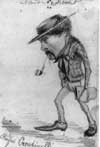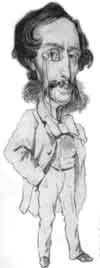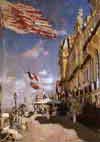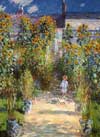




|
- Claude Oscar Monet History-
|
||





|
||
| > C h i l d h o o d 1 8 4 0 - 1 8 5 6 | ||



|
Oscar-Claude Monet came into the world in Paris on November 14, 1840 as the second son of Louise-Justine and Claude-Adolphe Monet. The young family lived at no. 45, rue Laffite in simple circumstances, like most of the residents, like most of the residents of the district around Montmartre. The locality would later become a desirable address for the best-known art dealers in France. Monet's parents apparently ran a samll shop, but this was so unsuccessful that in 1845 the family left Paris and rested in Le Hervre in Normandy. Claude's father found new employment in the flourishing groceries business runn by his brotherin-law. Henceforth, Claude and his brother Leon thus grew up in relatively welloff and secure circumstance. When Jacques Lecadre died in 1858, Adolphe Monet took over his brotherin-law's business and took charge of the welfare of the whole family. After the premature death of his mother in 1857, young Oscar-Claude developed a closer relationoship with his aunt, Marie-Janne Lecadre, an amateur painter. His relationship with his father was generally strined. Claude went to the city lycee in Le Harvre, much to his chagrin, as he was not naturally academic and became bored. During lessons, he preferred to draw garlands in his exercise books or toss off caricatures of his teachers. These and other sketches in his first school record books demonstrate the precocious drawing abilities of the young Monet, despite the subjects coming largely from his textbooks. At any rate, even at this time Monet's talent must have been encouraged, because the school was fortunate to have an art master of some standing in Francois Ochard, a pupil of Jacques-Louise David,who was a celebrated history painter in his day. The "portraits" of his teachers soon became much prized among his fellow pupils, bringing Monet his first recognition. By the time he finally left school between 1855 and 1875, presumably without matriculating earned his first money with his caricatures of this kind. Word of Monet's wicked eye for the people around him soon got about in Le Havre. This happy circumstance was due not least to the fact that in 1856/57 he was allowed to exhibit his drawings in the window of Gravier's artist supplies and frame shop in the Rue de Paris.
Though caricature did not count as an indeprndent artistic genre, due to the new technique of steel engraving it had since 1830 become an everday and highly popular feature in the daily press. His drawings were quite clearly to the public's taste, as the young artist had soon earnd a proud 2,000 francs with them - commercila success and early frame that the ambitious young entrepreneur noted with satisfaction as a first step in his career. |
|
| > T r a i n i n g 1 8 5 7 - 1 8 6 4 | ||







|
Inasmuch as Monet ever thought of an artistic career in his youth, that of a landscape printer must have seemed the least likely. This was due less to his successes as a caricaturist than the low prestige accorded at that time to landscape paintings and the consequent problem there was in selling them. Monet's encounter with Boudin in 1856 was promoted by Gravier the frame-maker. Boudin had had little success as a landscape painter. Nonetheless, he advised Monet, 16 years his junior, not to limit himself to drawing caricatures but to try his hand at painting as well. After some hesitation, Claude finally decided to accompany Boudin on his trips to the Atlantic coast. As Monet said, at first he daubed qway quite happily, but soon learnt to appreciate Boudin's quiet, simple landscape paintings and let himself be guided by him. In small, tentative oil sketches he now practised looking accuretly, and learnt how to translate the color and shape of nature into his pictures.Above all, his teacher taught him how to depict moods of light and cloud formations, as Boudin was intrested in representing nature as such and had no interest in the nymphs and historical figures with which his contemporaries decked out their landsacpe paintings. An enthusiastic pupil, Money translated Boudin's advice into his own picturres so convincingly that he was already exibiting a painting at the Le Harvre art exhibition in 1858. His decision to become a painter was now final, regardless of his father's opposition. However, the latter preceived his son was not to be moved, and applied for public schorlarship for his traning. The scholarship application was turned down, on the grounds of his earlier, less serious drawing career but, due to his savings from that same "career" Claude had already left for Paris without waitng for the answer. Monet arrived in Paris at the begining of May 1859. His family had no objections to a state-recognized artist's career becouse the prospective earnings for a history or portrait painter were good. Bearing letters of recomendation and with two stilllifes tucked under his arm, Monet immediately called on established Salon painters. In the ens he enrolled at the Academie Suisse, a cheap studio that unfortunately did not enjoy the approval of the Ecole des Beux-Arts and therefore endangered Monet's artistic career. Indeed, his father immedediatley withdrew financial support. Monet now passes his time in Brasserie des Martyrs. There he drew and continued to sell caricatures to replenish his dwindling savings. Vigorous discussions about current issues in art also featured. His time at the Academi Suisse was terminated by his call up for military services in 1861. However in 1862 he returned to Paris after his aunt had bought him out of the military service, and this time, because of his familiy, enrolled at the famouse studio of the painter Charles Gleyre. In contrast to the discontented Monet, his fellow pupils were initially keen to learn. The young painters were increasingly unable to identify with Glere's traditional approach to art. In 1863 they left to paint in the open air of the fontainebleau forest.
From 1863 Monet and his friends traveled to Chailly wich is situated on the edge of Fontainebleau forest. The idea was that that the group should paint in the open. Away from the hectic life from Paris, the art students practised reproducing the effects of light in pictures. Monet's pictures from this time testify to his extraordinary ability to chose the right section of lanscape, to proportion all the pictorial features correctly and generate spatial depth. | |
| > R e s t l e s s S e a r c h 1 8 6 5 - 1 8 7 1 | ||


|
The years preceding the Franco-Prussian war were a time of desperate financial hardship for Monet. He and his partner Camile frequently had to change address to escape creditiors. The pictures he submitted to the Salon were repeatedly rejected, so that he began to fear for his career. In August 1867, Camille bore Monet's first son Jean, but Monet had to postpone his wedding, again becouse of a shortage of money. In 1870, shortly before war was broken out, Monet finally married Camille and fled with her to London to escape conscription. After a very unproductive time in England, in wich Monet nonetheless established important contacts with art delers and other artist, the young family passed a happy summer in Zaandam in Holland, returning to Paris in November 1871 after the war had ended. Monet produced a few city views, but these were irrelevant to the work of the landscape painter. Monet soon renewed his contacts with the Paris art scene as well. He and his old teacher Boudin stirred themselves to help the noted painter Gustave Courbet, who hab been arrested as an insurgent in March during the Paris Communce uprising against the Versailles goverment. Although normally apolitical, Monet displayed both commitment and courage - traits which marked his public behevior on other, if infrequent occasion. | |
| >T h e I m p r e s s i o n i s t 1 8 7 2 - 1 8 8 0 | ||







|
After his return from Zaandam and a flying vist to Paris, Monet moved to Argenteuil. As it could be reached in 30 minutes from Paris by train. He was now often visited in Argenteuil by his friend Renoir, and the two of them undertook joint painting excursions around the countryside. At about this time Monet had his famous studio boat built in wich he rowed out on the water with his easel and as previously in Holland painted suprising and extrordinarily authentic water landscapes. Monet, Renoir, Cezanne, Sisley, and Pissarro got together with Manet, Jongkind, and others as an organization of artist and announced their intention in Parisian art periodicals, calling on all serious artist at once to join their ranks. This unconvwntional advertising campaign was sensible, becouse more artist took part, the less it would cost each of them. Moreover, the friends wanted established painters to join the group so as not to be mistaken for painters rejected by the Salon. On April 15, 1874 the artist organization opend its first monthlong exhibition in the former studio room of the photographer Nadar, in the Boulevard des Capucines. Monet himself showed 12 pictures, these included two of his masterpices of the period. Whereas the relatively few visitors who attended the exhibition displayed anusement, critical opinion was divided. Some sneered forthwith that the painters had probbably fired the painters at the canvas pistols, while others admired the convincing rendering of a fleeting moment in the Boulevard des Capucines. However, they criticized the sketchy execution that made the paintings look unfinished. The most momentous review of the exhibitions was written by the art critic Louis Leroy, who took Monet's title Impression, Sunrise as symptomatic for the whole of the style of the group and entitled his slating review "The Impressionists exhibition." In summer 1878 the Monets moved futher down the Seine to Vetheuil. The family of four, a second son, Michel, had been born in Paris in March. serious financial troubles afflicted Ernest Hoschede, a generous patron and client of Monet, declared himself bankrupt. He was forced to sell Monet's works for low prices, wich reduced their marked value perceptibly. The painter nontheless remained friends with Hoschede and his wife Alice, and even shared his house in Vetheuil with them. When Camille died a year later, in September 1879 alice took responsibility for Monet's two sons as well as her own six children. Encoureged by the public's growing interest, the publisher of the periodicla La vie moderne invited his to exhibit his first one-man show. The show helped to make Monet more popular. He was able to sell sevral of the works exhibited for good price. In summer 1881 before the move to Poissy, Monet painted his garden in Vetheuil, wich ran down to the Seine. As previously in Argenteuil, the forthcoming departure caused his to cast a farewell look at his home and garden. The garden pictures with their idylls of summer flowers in splendor and Monet's children playing illustrate the artist's yearning for harmony with his familiy and nature. Arter Camille's death, a closer relationship developed between Monet and Alice Hoschede, and when eventually her husband left the house, Monet suddenly become the father of eight children. Thus in November 1881 the now large family moved to Poissy, a somewhat bigger town also by the Seine, to enable the younger generation to obtain a proper education. |
|